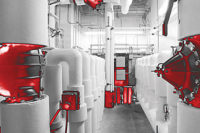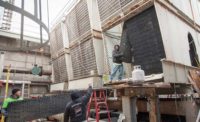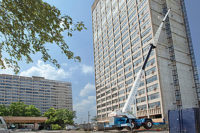Recently, new ultra-green initiatives demonstrate just how far the company is willing to push the envelope. It’s a good thing because — as we all know — the demand for resources increases as a company expands. Yet, MassMutual managers knew there was a better way.
The company’s 1.3 million-sq-ft headquarters in Springfield, MA includes hundreds of offices, a large kitchen and café, health center, multiple meeting and conference rooms and, on the rooftop, two solar arrays with enough “wow” factor to impress solar connoisseurs.
Now there are 96 four-by-ten-foot SS-40 solar thermal collectors manufactured by Solar Skies and a 528-panel photovoltaic array helping to offset some of the facility’s energy needs. Installed near the solar thermal panels, the REC Solar photovoltaic array provides the facility with 111 kW of electric energy generation.
Together, the two solar installations provide MassMutual with a combined savings of about $100,000/yr.
“Growing energy consumption was a concern for MassMutual both from a cost perspective and because of its impact on the environment,” said David Brown, vice president of MassMutual Corporate Real Estate and Facilities. “The solar installation was a great solution for both issues.”
Other modifications throughout the facility add to the successful retrofit. All the changes add up to substantial savings, but also resulted in a LEED® Silver certification, awarded in early April.
SUSTAINABILITY WITHIN REACH
“MassMutual considered solar years ago but never moved on it until recently, because we were waiting for the technology to become more efficient,” said Sean Anderson, assistant vice president of facilities operations. “Once the decision was made, the installation took very little time, thanks to a solid design.”
Absolute Green Energy Corporation, in Worcester, MA, completed nearly all of the solar design for the project, on both the photovoltaic (PV) array and the solar-thermal array.
“We’re the turnkey integrator for the MassMutual PV system,” said Mike Ortolano, president of Absolute Green Energy. “For the solar-thermal system, we did the engineering up front feasibility assessment and output estimates, then turned the design over to Harry Grodsky & Co., the mechanical contractor on the job. They did the system design-build.”
“For this latitude, a 37° pitch for the solar collectors is the annual optimum,” said Ortolano. “However, the collectors were set at 42°, which provides slightly better performance in the winter, due to seasonal orientation and snow shedding.” Ortolano is quick to point out the exact pitch is far less important than most people would expect. In fact, the PV collectors at MassMutual are at 20° so a ballast mounting system could be used.
Going with a lower pitch makes the use of a ballast system possible. The advantage of a ballast, or weighted system, is the elimination of roof penetrations. The solar array is simply “weighted down” to the roof. The higher the pitch on the panels, the more they act as sails, increasing the weight needed to hold down the array.
The roof itself was replaced just before the solar arrays were installed. The new roof is a heat-shedding white PVC membrane, and receives the added benefit of protective shading by the large solar arrays.
Although the solar arrays are the facility’s most substantial green enhancement, MassMutual is no newcomer to the cause for sustainability. Their track record proves it. The main facility has electric car charging docks, offering free power to employees who commute to work in electric automobiles. The company also promotes a car pool program, with nearly 300 participating employees.
In addition to the solar installation, the best energy recovery technology is installed within the large kitchen’s venting system. Exhaust fans are triggered by smoke and temperature, rather than running constantly, saving an estimated $35,000/yr.
HEAVY DUTY HOT WATER
“The solar array is capable of providing up to 50% of the 4,900 gal of 180°F water required each day,” said engineer Mark Jurkowski, head of the design-build department for Harry Grodsky & Co., Inc., the firm chosen by MassMutual to design, install, and service its mechanical systems. “Alone, the new solar thermal system saves the company around $30,000 a year.”
The closed-loop solar thermal array produces 540,000 Btuh. The energy takes a circuitous yet very efficient journey before reaching water fixtures throughout the building.
A set of Taco 1941 solar collector pumps circulates water from the solar array through two brazed plate, 330 MBtuh heat exchangers. The solar installation operates at a 15° Delta T, with a maximum solar loop temp of 220°, and a target temp of 205° in the hot water tanks. Given the extreme pressure changes that solar loops can endure, a Taco CBX Series expansion tank was used to protect system components. The solar loop also includes a 3-in., 4900 Series micro-bubble air separator with internal pall rings designed to remove dirt particles as small as 35 microns in diameter.
Within the potable water system, a pair of Taco 1919B domestic water pumps circulates water through the brazed plate heat exchangers into four, 500-gal storage tanks. These ‘solar target’ tanks are connected to another 1,000 gal of existing hot water storage. This reserve, under normal conditions, is used to supply hot water directly to all potable water points-of-use within the building.
The second loop from the heat exchanger tempers water from the utility supply. This solar-tempered water is used as the supply for two existing, 670 MBtuh, gas-fired water heaters.
The existing hot water system supplies the other 50% of heat for domestic water. In the winter, the storage tanks tap four, 25MMBtuh Babcock & Wilcox steam boilers that provide space heat for the entire 99-acre, eight-building campus. During the summer, when space heat isn’t needed, the steam plant shuts down and the two gas water heaters are activated.
As a safety mechanism, the solar array is designed to meet half of the facility’s hot water needs. Without a ‘dump load’ to back the system up in a case of emergency, in addition to other safety devices, 50% of the domestic hot water is the most a solar array can safely supply.
A dump load flushes heat from the system into another body of water, in the event that the glycol in the array reaches critical temperatures. Oftentimes, the hydronic heating system for a building can be used as the dump load, but the MassMutual campus uses a steam system.
In this system, when the 4,000 gal of hot water storage exceeds 205°, a control valves opens, dumping hot water down a drain. At the same time, another valve opens, allowing 55° city water to enter the storage tanks. The control valves stay open until the tank temperature drops to 190°.
The most likely scenario for this to occur would be a sunny weekend, where there is little or no call for hot water from the facility. If for some reason the control valves wouldn’t open, there is a fail-safe: emergency relief valves that are set to open at 210°.
The reason MassMutual can store so much water at such a high temperature is because of the mixing capabilities found in the mechanical room and the wide variety of temperatures the facility calls for. Three different water temperatures are used throughout the building. The bathrooms and locker rooms call for 120° water, while the kitchen uses 140° water at almost all fixtures. The industrial dishwashers use 180° water.
LEED®SILVER SYSTEM
A year before the solar project started, Harry Grodsky & Co. replaced more than 400 toilets and urinals with low-flush models. Also, as part of the water conservation effort, aerators were installed on all faucets. Combined, these two changes eliminate over 5.6 million gal of water purchased annually. Including sewer treatment cost, it’s saving MassMutual an additional $30,000.
“We replaced an old chiller system in another building on campus at the same time we were there for the hot water project,” said Jurkowski. Two old 120-ton reciprocating chillers were torn out and replaced with an ultra-high efficiency McQuay frictionless system.
Two Taco FI4011 chilled water pumps move water from the chiller unit to five large AHUs. Additionally, water is supplied to four fully-redundant Liebert computer room HVAC systems. These serve a 1,500-sq-ft printing facility within the main building where temperature and humidity must be carefully controlled. Two Taco condenser pumps move water from the chiller unit to the cooling tower. These system enhancements are estimated to save about 360,000 kWh in energy consumption.
With these and other ongoing energy improvements happening campus-wide, MassMutual has earned the privilege to point proudly to its green initiatives.
“The solar installation is an excellent addition to our facility,” concluded Anderson. “Now we have new reason to be disappointed when the sun doesn’t shine. Combined with all the other changes, we’re reaping the benefits of going green every day.”ES











